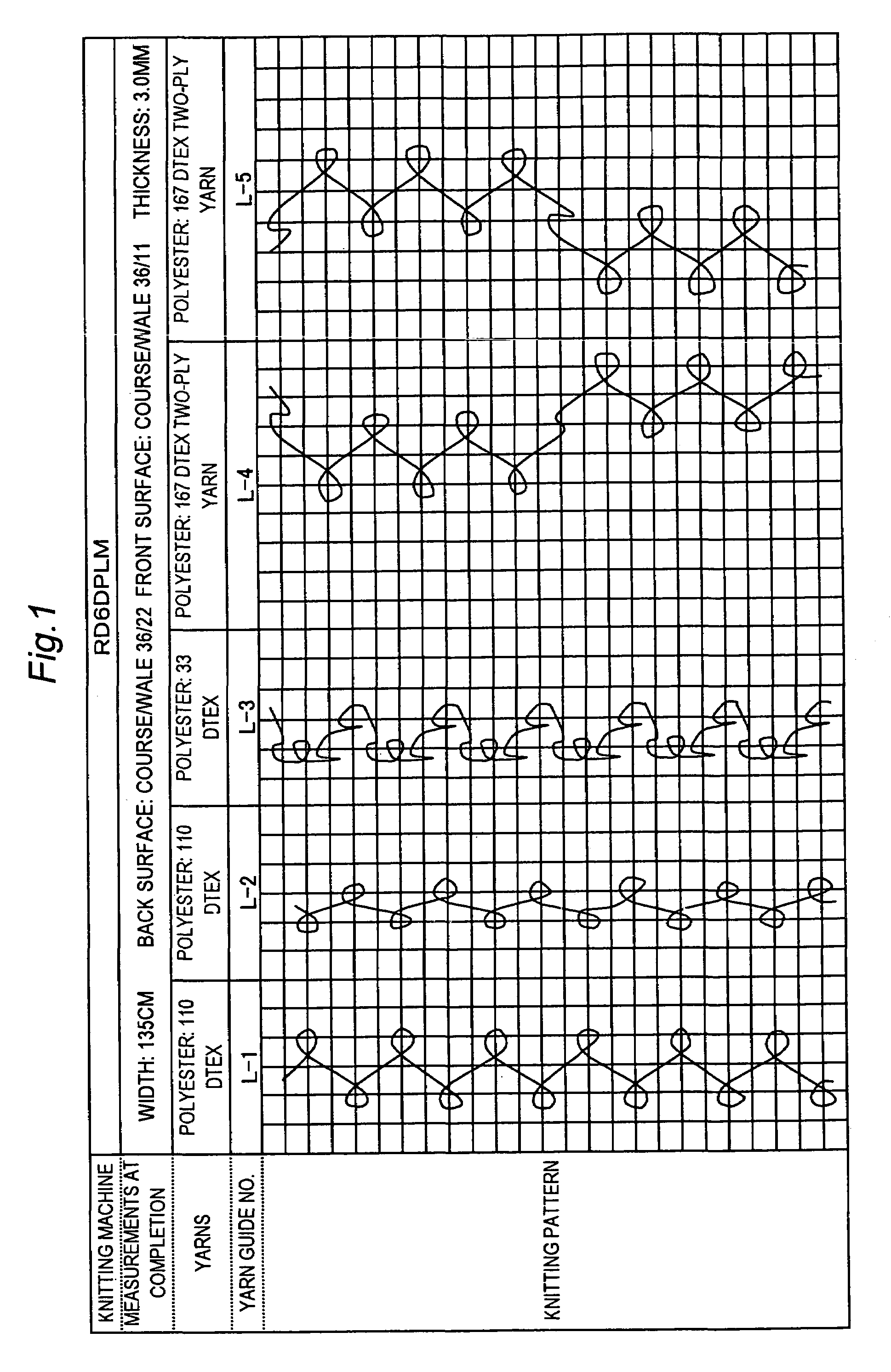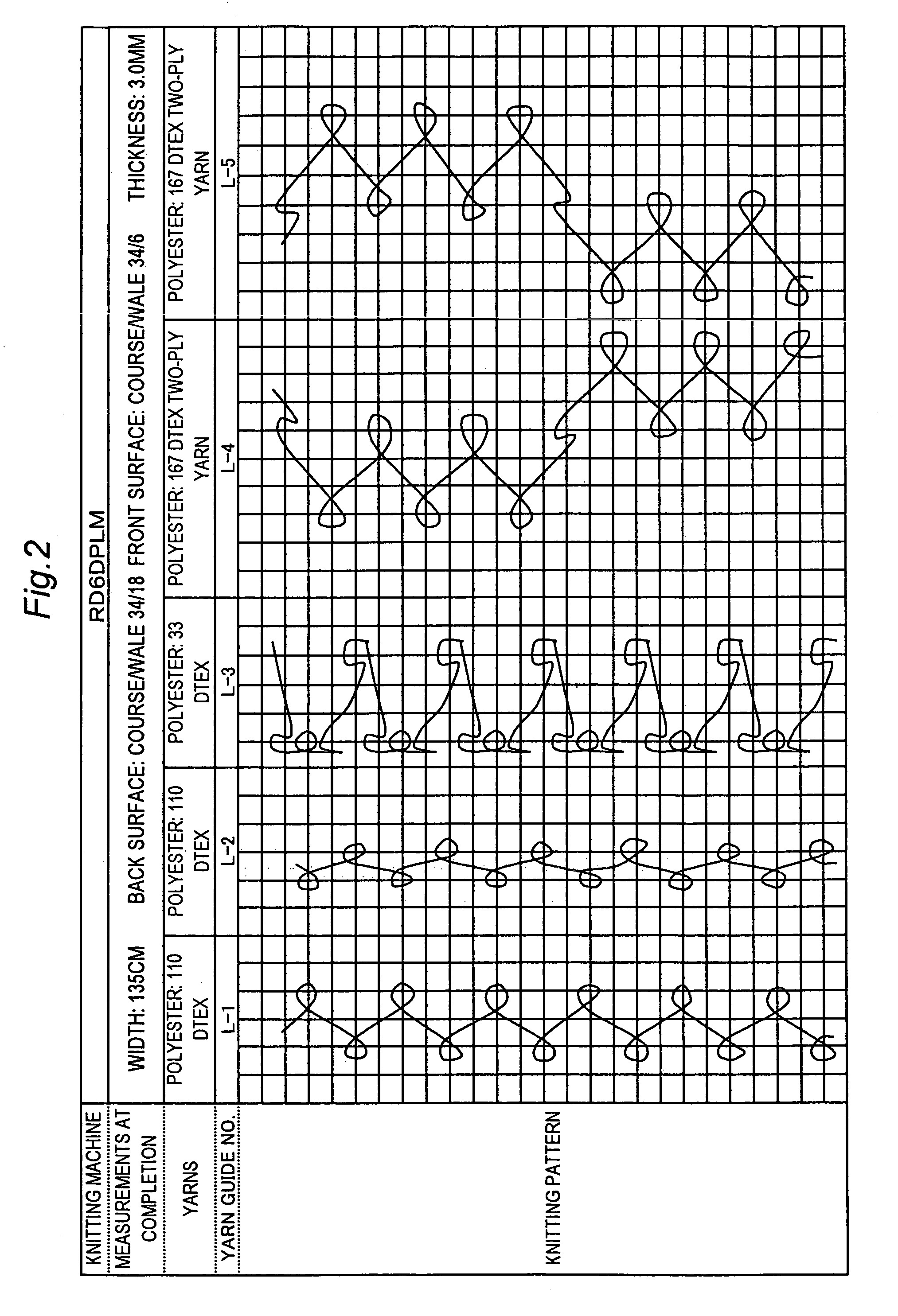Warp knit fabric with steric structure
a technology of steric structure and warp knit fabric, which is applied in the field of three-dimensional warp knit fabric, can solve the problems of poor breathability and amenity, difficulty in maintaining shape, and deterioration of texture, and achieves superior cushioning property and shape retaining property, reduce contact area, and reduce the effect of contact area
- Summary
- Abstract
- Description
- Claims
- Application Information
AI Technical Summary
Benefits of technology
Problems solved by technology
Method used
Image
Examples
example 1
[0044]A warp-knitting machine (RD6DPLM) of Mayer Co. is used. The ground structure having the larger number of loops was knitted using 22 knitting needles per inch. The ground structure having the smaller number of loops and having openings of a meshwork was knitted using 11 knitting needles per inch. The two ground structures were connected by connecting yarns, as to form a three-dimensional warp-knitted fabric in accordance with a knitting pattern shown in FIG. 1. The thickness of the warp-knitted fabric was 3.0 mm; and the knitting density per inch of the ground structure having the larger number of loops at completion of the knitting was 36 courses and 22 wales; and the knitting density per inch of the ground structure having the smaller number of loops was 36 courses and 11 wales at completion of the knitting. The per-area weight of the ground structure having the smaller number of loops was 150 g / m2; the per-area weight of the ground structure having the larger number of loops...
example 2
[0045]The warp-knitting machine (RD6DPLM) of Mayer Co. was used. The ground structure having the larger number of loops was, knitted using 18 knitting needles per inch, and the ground structure having the smaller number of loops and having openings of a meshwork was knitted using 6 knitting needles per inch. Both of these ground structures were connected by connecting yarns to form the three-dimensional warp-knitted fabric in accordance with a knitting pattern shown in FIG. 2. The thickness of the warp-knitted fabric was 3.0 mm; and the knitting density per inch of the ground structure having the larger number of loops was 34 courses and 18 wales at completion of the knitting; and the knitting density per inch of the ground structure having the smaller number of loops was 34 courses and 6 wales at completion of the knitting. The per-area weight of the ground structure having the smaller number of loops was 110 g / m2; the per-area weight of the ground structure having the larger numbe...
example 3
[0046]The warp-knitting machine (RD6DPLM) of Mayer Co. is used. A ground structure having the larger number of loops was knitted using 28 knitting needles per inch; and a ground structure having the smaller number of loops having openings of a meshwork was knitted using 21 knitting needles per inch. Both of these ground structures were connected by connecting yarns to form a three-dimensional warp-knitted fabric in accordance with a knitting pattern shown in FIG. 3. The thickness of the warp-knitted fabric was 3.0 mm; and the knitting density per inch of the ground structure having the larger number of loops was 36 courses and 28 wales at completion of the knitting; and the knitting density per inch of the ground structure having the smaller number of loops was 36 courses and 21 wales at completion of the knitting. The per-area weight of the ground structure having the smaller number of loops was 190 g / m2; the per-area weight of the ground structure having the larger number of loops...
PUM
| Property | Measurement | Unit |
|---|---|---|
| size | aaaaa | aaaaa |
| weight | aaaaa | aaaaa |
| diameter | aaaaa | aaaaa |
Abstract
Description
Claims
Application Information
 Login to View More
Login to View More - R&D
- Intellectual Property
- Life Sciences
- Materials
- Tech Scout
- Unparalleled Data Quality
- Higher Quality Content
- 60% Fewer Hallucinations
Browse by: Latest US Patents, China's latest patents, Technical Efficacy Thesaurus, Application Domain, Technology Topic, Popular Technical Reports.
© 2025 PatSnap. All rights reserved.Legal|Privacy policy|Modern Slavery Act Transparency Statement|Sitemap|About US| Contact US: help@patsnap.com



